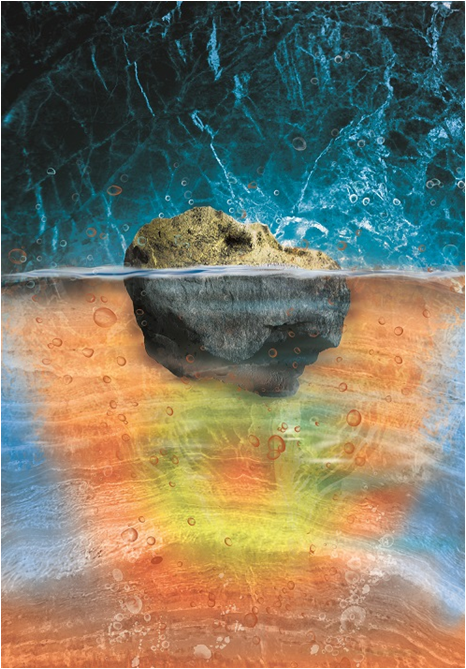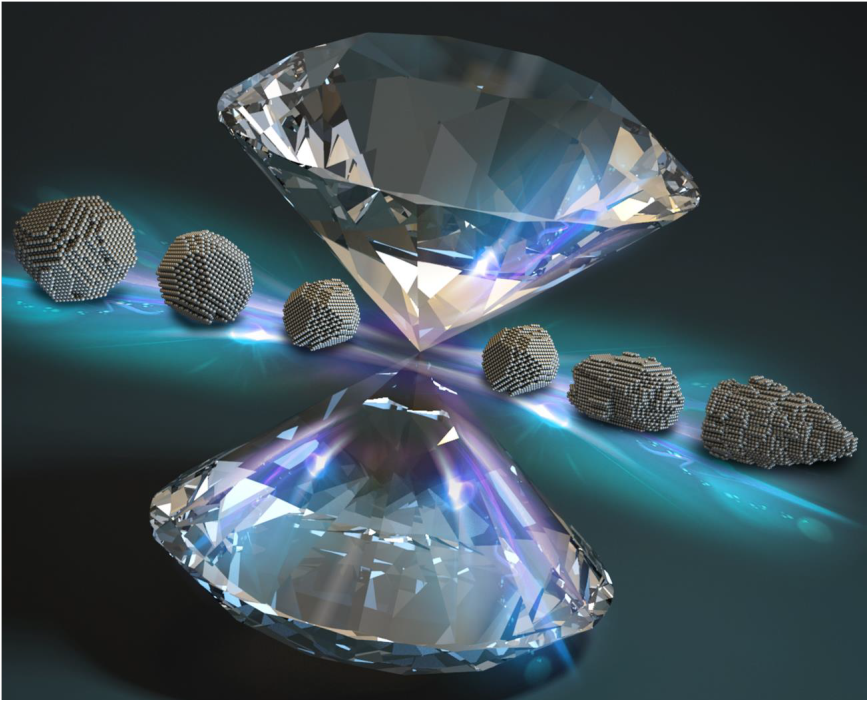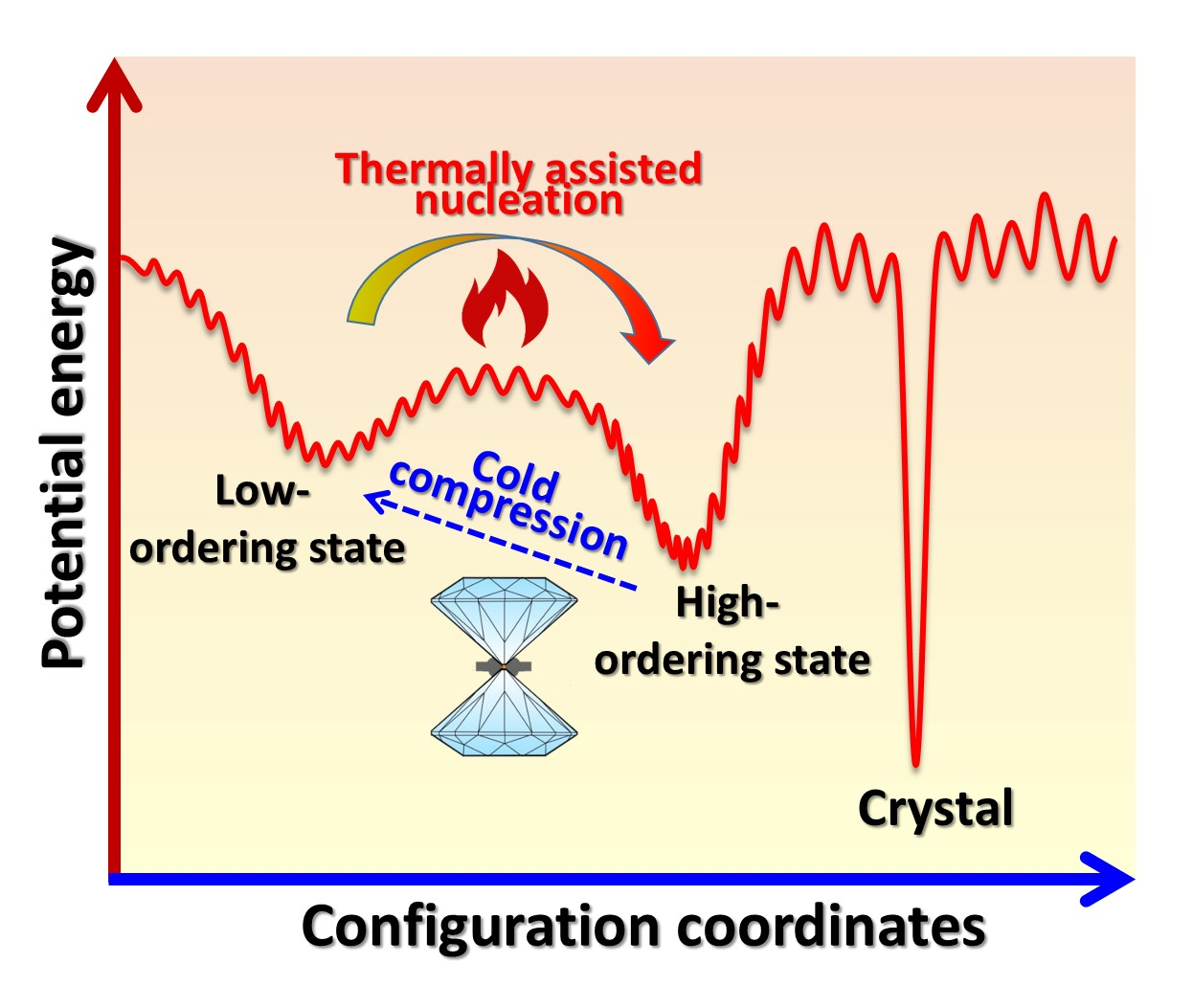

JULY 17, 2020 — An international team led by Dr. Xujie Lü and Dr. Wenge Yang from the Center for High Pressure Science and Technology Advanced Research (HPSTAR) discovered that lattice compression under a mild pressure considerably suppresses the carrier trapping of a 2D perovskite (HA)2(GA)Pb2I7, leading to significantly enhanced emission. Intriguingly, a new phase obtained after pressure...

JUNE 23, 2020 — The glass structure of a material is often believed to mimic its corresponding liquid. Polyamorphism between ices has been used as a guide to elucidate the properties of liquid water. But how many forms of amorphous ices are there? Do we understand how metastable high-pressure crystalline ice evolves towards the thermally stable low-density form? An international research team led ...

JUNE 11, 2020 — An international joint research team led by Professor Yongjae Lee from Yonsei University and HPSTAR, and Dr. Toshimori Sekine and Dr. Wenge Yang of HPSTAR reported how the structure of iron changes when a rapid impact is applied using ultra-fast X-ray measurement technique. Structural changes at the atomic level of iron in such a shock situation provide a fundamental understanding...

JUNE 5, 2020 — An international team co-led by Ho-Kwang Mao and Huiyang Gou from Center for High Pressure Science and Technology Advanced Research (HPSTAR) and Yansun Yao from University of Saskatchewan discovered that nitrogen, usually consisting of diatomic molecules, can form an extended structure under the conditions of 1.5 million atm pressure and 1,900 °C. In the new structure, all nitrogen ...

JUNE 02, 2020 — In an international collaboration of scientists based at HPSTAR, Hefei institute of Solid-state physics and the University of Edinburgh, the phase diagram of the fundamental ternary molecular alloy, bearing isotopes: hydrogen (H2) deuterium (D2) and hydrogen deuteride (HD), was carried out to the most extreme conditions, up to 200 GPa and down to 13 K. These extensive measurements,...

MAY 27, 2020 — Subduction of hydrous materials imposes a great influence on the structure, dynamics, and evolution of our planet. However, it is largely unclear how subducting slabs chemically interact with the middle mantle. Recently, an oxygen-excess phase (Mg,Fe)2O3+δ was discovered under the Earth’s middle mantle conditions (~ 1000-2000 km) by a team of scientists from the Center of High...

MAY 13, 2020 — If we took a journey from Earth’s surface to the center, the midway point locates roughly at 1900 km depth in the lower mantle. The lower mantle ranges from 660 to 2900 km depth and occupies 55% of our planet by volume. The chemical composition of the lower mantle is rather simple. It has long been pictured as being made up of 2 major minerals (~95%), namely bridgmanite and...

MAY 7, 2020 — New study led by Dr. Gang Liu from HPSTAR reported a new type of morphotropic phase boundary (MPB) in relaxor-PbTiO3 crystals. Such a novel MPB, referred as “diffused MPB”, results in both high piezoelectricity and thermal stability simultaneously, which is critical for the applications of ferroic materials. This work redefines the core concept in ferroelectrics, and opens a new way ...

APRIL 26, 2020 — The search for polyhydride materials at high pressure has produced numerous predictions focused almost entirely on metallic superconductors. Intriguingly, a series of independent studies have postulated the anomalous emergence of semiconducting and semimetallic polyhydrides unique to the group 8 metals Fe, Ru, Os. Despite extensive study these materials have remained entirely...

MAY 11, 2020 — How does nanostructured silicon deform has been the subject of a long-standing debate over the past decade. Now recent research from a team of scientists led by Dr. Zhidan Zeng from HPSTAR clarifies that pressure-induced phase transitions play a key role in the plastic deformation of compressed silicon nanoparticles. Their findings are reported in Physical Review Letters (DOI: 10.11...

MARCH 5, 2020 — New study from a team of scientists led by Dr. Qingyang Hu and Prof. Shengcai Zhu from Sun Yat-sen University found a quasi-reconstructive phase transition in ZnTe under different stress conditions. While phase transitions come in either displacive or reconstructive type, it occurs simultaneously in ZnTe when it was under pressure. The special type of phase transition reveals a...

FEBRUARY 25, 2020 — According to the well-known Hall-Petch relationship, the strength of nanometals decreases when the grain size is smaller than 10 to 15 nanometers. New high-pressure compression study from a team of scientists led by Dr. Bin Chen from HPSTAR and Prof. Xiaoxu Huang from Chongqing University detected the strengthening in nano-grained nickel down to 3 nanometers. The yield strength...

JANUARY 18, 2020 — New study from a team of scientists co-led by Dr. Duckyoung Kim from HPSTAR synthesized a new iron-based 2D ferromagnetic metal material, Fe4GeTe2 with the help of theoretical design. This new 2D ferromagnetic metal shows a nearly room temperature ferromagnetic order, together with a large magnetization and high conductivity and these properties could be retained in cleaved...

JANUARY 17, 2020 — Metallic glasses are disordered alloys with many properties superior to conventional crystalline metals. Unlike crystalline materials that follow strict atomic-packing rules and imposed symmetry, in principle, metallic glasses have a high degree of freedom to arrange their atoms with almost infinite possibilities in their configuration space. However, in practice, effectively...

JANUARY 3, 2020 — New work from a team of scientists led by Dr. Yang Ding from HPSTAR discovered a novel superstructure in 1T-type vanadium diselenide (VSe2) that converts sample from two-dimensional to three-dimensional at pressures >16 GPa (room temperature). They revealed that the pressure-induced superstructure is driven by the Fermi-surface nesting and at the same time enhanced by vanadium...

DECEMBER 17, 2019 — New study from a team of scientists co-led by Drs. Qingyang Hu and Ho-kwang Mao from HPSTAR, discovered that stishovite — a major mineral in deep mantle, can incorporate large amounts of water in its crystal structure and the hydrous stishovite may be a key phase for transporting and storing water in earth lower mantle. The research is published in the recent issue of the...

DECEMBER 15, 2019 — New study from a team of scientists led by Dr. Huiyang Gou of HPSTAR reported the synthesis of high-quality single crystal of molybdenum boride by multianvil technique, which enables the understanding of long-standing uncertainties in structure and composition about this highest boride in Mo-B system. The superior mechanical properties and superconductivity were revealed...

DECEMBER 14 — After long-term ploughing and weeding on functional materials with anti-perovskite structure, a joint group of scientists co-led by Dr. Yonggang Wang from HPSTAR, published a review paper on anti-perovskites with exceptional functionalities on Adv. Mater. (doi:10.1002/adma.201905007). This Review summarized recent advances in novel anti-perovskite materials with exceptional...

DECEMBER 10, 2019 — Understanding the mechanism of volume collapse phenomena in rare-earth materials remains an important challenge in part due to lack of direct information on 4f electronic structures at highpressures. A group of scientists led by Dr. Yang Ding of HPSTAR, reported the first high-pressure inelastic x-ray scattering measurement on elemental cerium (Ce) metal. Their work revealed...

DECEMBER 3, 2019 — New study from a team of scientists co-led by Dr. Cheng Ji and Dr. Ho-kwang Mao from HPSTAR performed the first combined infrared-Raman experiments on hydrogen phase IV, up to 280 GPa. By utilizing an advanced spectroscopy system which incorporates synchrotron Infrared (IR) spectroscopy and Raman spectroscopy at Shanghai Synchrotron Radiation Facility and toroidal diamond anvils...